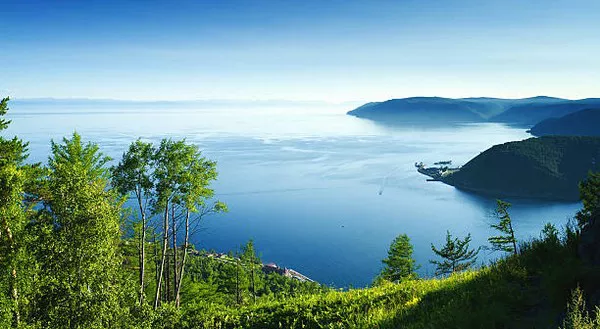Lakes, the serene bodies of water, have always captivated the human imagination. They are not just reservoirs of freshwater but also repositories of natural wonders, each with its unique ecosystem and geological history. Among the myriad lakes scattered across the globe, some stand out not only for their vast expanse but also for their incredible depth. In this article, we embark on a journey to explore ten of the world’s deepest lakes, delving into their depths, geological formations, and the ecological treasures they harbor.
Top 10 Deepest Lakes In The World
1. Lake Baikal, Russia
Lake Baikal, located in southern Siberia, holds the distinction of being the world’s deepest and oldest freshwater lake. Its immense depth of approximately 5,387 feet (1,642 meters) earns it a place among the planet’s most profound natural wonders. Formed over 25 million years ago, Lake Baikal is a geological marvel, encompassing around 20% of the world’s unfrozen freshwater reserve.
Beyond its depth, Lake Baikal boasts unparalleled biodiversity, with over 1,700 species of plants and animals, two-thirds of which are found nowhere else on Earth. The lake is also home to the world’s only freshwater seal, the Baikal seal or nerpa. Its crystal-clear waters, formed by the unique combination of ancient geology and minimal human disturbance, make Lake Baikal a UNESCO World Heritage Site and a source of scientific fascination.
See Also: Unveiling the World’s 5 Largest Oceans!
2. Lake Tanganyika, Africa
Nestled amidst the Great Rift Valley in East Africa, Lake Tanganyika is not only the second deepest lake globally but also the longest, stretching over 420 miles (676 kilometers). With a maximum depth of approximately 4,823 feet (1,470 meters), this ancient lake is a hotspot of biological diversity, hosting an array of endemic species, including cichlid fish and snails.
Geologically, Lake Tanganyika is part of the East African Rift system, formed millions of years ago by tectonic activity. Its deep waters, enriched by nutrient upwelling, sustain a thriving ecosystem, supporting local fisheries and sustaining livelihoods for millions of people in the surrounding region.
3. Caspian Sea, Asia-Europe
Spanning the divide between Asia and Europe, the Caspian Sea holds the title of being the world’s largest lake by both surface area and volume. Though often referred to as a sea due to its size and saline nature, the Caspian is, in fact, an endorheic basin, entirely surrounded by land. With a maximum depth of approximately 3,363 feet (1,025 meters), the Caspian Sea ranks among the deepest lakes globally.
The Caspian Sea’s geological history is as complex as it is ancient, shaped by the collision of tectonic plates and changing sea levels over millions of years. Despite its high salinity, the Caspian supports a unique ecosystem, including sturgeon, which are prized for their caviar, and endemic species adapted to its brackish waters.
4. Lake Malawi, Africa
Lake Malawi, also known as Lake Nyasa in Tanzania and Lago Niassa in Mozambique, is one of Africa’s Great Lakes and the third deepest lake on the continent. Its maximum depth of approximately 2,316 feet (706 meters) is a testament to its ancient origins and geological significance.
Formed by the Great Rift Valley, Lake Malawi is renowned for its staggering biodiversity, with over 1,000 species of cichlid fish, most of which are endemic to its waters. The lake’s crystal-clear waters, fringed by sandy beaches and rocky outcrops, make it a haven for snorkelers, divers, and nature enthusiasts alike.
5. Great Slave Lake, Canada
North America’s deepest lake, the Great Slave Lake, is a shimmering expanse nestled in the heart of Canada’s Northwest Territories. With a maximum depth of approximately 2,015 feet (614 meters), it ranks among the world’s deepest lakes and serves as a vital freshwater reservoir for the region.
Formed by glacial processes during the last Ice Age, the Great Slave Lake sustains a diverse ecosystem, supporting fish species such as lake trout, whitefish, and northern pike. Its pristine waters and rugged shoreline also attract outdoor enthusiasts seeking solitude and adventure in Canada’s vast northern wilderness.
6. Lake Matano, Indonesia
Located on the island of Sulawesi in Indonesia, Lake Matano is not only one of the world’s deepest lakes but also the tenth deepest overall. With a maximum depth of approximately 1,936 feet (590 meters), Lake Matano is a geological wonder formed by tectonic processes millions of years ago.
Despite its depth, Lake Matano is remarkably clear and pristine, with waters teeming with endemic species of fish, including several species of cichlids. The lake’s surroundings, characterized by lush rainforests and towering mountains, add to its allure, attracting scientists and nature enthusiasts from around the world.
7. Hornindalsvatnet, Norway
Hornindalsvatnet, nestled amidst the majestic fjords of western Norway, holds the distinction of being Europe’s deepest lake. With a maximum depth of approximately 1,686 feet (514 meters), it plunges to impressive depths carved by glacial activity during the last Ice Age.
Despite its depth, Hornindalsvatnet is relatively small in size compared to other deep lakes, spanning only 14 square miles (36 square kilometers). Its pristine waters, fed by glacier melt and rainfall, support a thriving ecosystem of fish and aquatic plants, making it a popular destination for fishing and outdoor recreation in Norway.
8. Lake Geneva, Switzerland/France
Nestled between the Alpine peaks of Switzerland and France, Lake Geneva, or Lac Léman, is one of Europe’s largest and deepest lakes. With a maximum depth of approximately 1,220 feet (372 meters), it ranks among the continent’s deepest natural wonders.
Formed by glacial processes during the last Ice Age, Lake Geneva is renowned for its picturesque beauty, with charming lakeside towns and vineyard-covered hillsides dotting its shores. Its clear blue waters and stunning mountain backdrop make it a popular destination for sailing, swimming, and leisurely cruises year-round.
9. Crater Lake, United States
Crater Lake, located in Oregon’s Cascade Range, is not only the deepest lake in the United States but also one of the most awe-inspiring. Formed over 7,000 years ago by the collapse of the Mount Mazama volcano, Crater Lake plunges to a maximum depth of approximately 1,949 feet (594 meters).
Renowned for its intense blue color and pristine clarity, Crater Lake is a natural wonder steeped in Native American legends and geological history. Its unique ecosystem, devoid of any inlet or outlet streams, is home to a variety of endemic species adapted to its cold, nutrient-rich waters.
10. Lake Tahoe, United States
Nestled high in the Sierra Nevada mountains on the border of California and Nevada, Lake Tahoe is not only one of the deepest lakes in the United States but also one of the most iconic. With a maximum depth of approximately 1,645 feet (501 meters), Lake Tahoe’s crystal-clear waters and stunning alpine scenery draw millions of visitors each year.
Formed over two million years ago during the Ice Ages, Lake Tahoe is renowned for its remarkable clarity, with visibility reaching up to 70 feet (21 meters) in some areas. Its deep blue waters, framed by snow-capped peaks and dense forests, offer endless opportunities for outdoor recreation, from skiing and snowboarding in winter to hiking and water sports in summer.
See Also: List of 10 Largest Lakes In The World By Volume
Conclusion
From the depths of Siberia to the heights of the Sierra Nevada, the world’s deepest lakes are more than just bodies of water; they are windows into our planet’s geological past and ecological richness. These natural wonders, shaped by millennia of geological processes and human interaction, remind us of the interconnectedness of Earth’s systems and the importance of preserving our freshwater resources for future generations to enjoy.
As we continue to explore and appreciate the beauty of these deep lakes, let us also strive to protect and conserve them, ensuring that they remain pristine havens of biodiversity and sources of inspiration for generations to come. Whether it’s the ancient depths of Lake Baikal or the alpine splendor of Lake Tahoe, each of these lakes offers a glimpse into the majesty and wonder of the natural world, inviting us to delve deeper into their mysteries and marvels.
You Might Be Interested In:
























